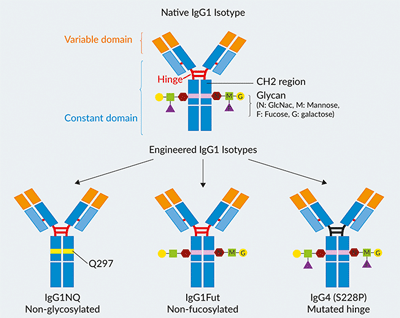Biosimilar Antibodies
Biosimilar isotypes derived from clinically relevant antibodies
Monoclonal antibodies (mAbs) have become a major tool in autoimmunity and cancer research. They function through various mechanisms with the ultimate effect of priming either the innate or adaptive arm of the immune system.
The efficacy of antibodies is governed by their bifunctional nature: the variable region confers antigen specificity and the constant region triggers antibody-mediated effector functions by engaging a variety of Fc receptors.

Examples of Strategies to Modify IgG mAb Isotypes
These effector functions include complement-dependent cytotoxicity (CDC), antibody-dependent cellular cytotoxicity (ADCC), and antibody-dependent cellular phagocytosis (ADCP).
One approach employed to enhance the efficacy of therapeutic mAbs is to modify the immunoglobulin (Ig) constant region.
Natural isotypes:
- IgG1 - induces potent ADCC, ADCP, and CDC
- IgG2 - induces poor ADCC and ADCP, while retaining some CDC function
- IgA2 - induces low ADCC and ADCP, and no CDC
Engineered isotypes (for modified effector functions):
- IgG1fut - induces increased ADCC due to defucosylation of the glycan sequences
- IgG1NQ and IgG1 (N298A) - induce no ADCC nor ADCP, and only minimal CDC due to mutations in glycosylation sites of the CH2 region
- IgG4 (S228P) - induces poor ADCC, ADCP, and no CDC with an engineered hinge region mutation (S228P) to prevent IgG4 molecules exchange
Therefore, InvivoGen provides a series of biosimilar antibodies for research only. They feature the variable region sequences of therapeutic antibodies, such as anti-human CD20, anti-HER2, and anti-human PD-1, available in their original format or with different Ig isotypes, either native or engineered. These antibody isotype families will help to study and compare effector functions between different isotypes and determine which isotype is the most suitable for research application.
InvivoGen’s research-grade biosimilars are generated by recombinant DNA technology, produced in Chinese hamster ovary (CHO) cells, and purified by affinity chromatography. They contain the human or murine kappa light chain, are sterile, free of sodium azide, and are validated by flow cytometry.
Large quantities are available upon request (see list below).
| Effector functions | Human isotypes | Mouse isotypes | |||||||||||||
| IgG1 | IgG2 | IgG3 | IgG4 | IgM | IgA1 | IgA2 | IgE | IgG1NQ | IgG1fut | IgG4S228P | IgG1 | IgG2a | IgA | IgG1e3 | |
| ADCC | ++ | +/- | ++ | +/- | + | + | + | + | - | ++++ | +/- | +/- | ++ | + | - |
| ADCP | +++ | +/- | ++ | + | - | + | + | - | - | +++ | + | + | +++ | + | - |
| CDC | ++ | + | +++ | - | +++ | - | - | - | +/- | ++ | - | - | ++ | - | - |
![]() Read our review on Antibody Isotypes
Read our review on Antibody Isotypes
![]() Read about biosimilar immune checkpoint mAbs
Read about biosimilar immune checkpoint mAbs
InvivoGen provides the following combination of target and isotype:
Anti-CD20: hIgG1, hIgG2, hIgG3, hIgG4*, hIgM*, hIgA1*, hIgA2*, hIgE*, hIgG1NQ, hIgG1fut, hIgG4 (S228P), mIgG1, mIgG1e3, mIgG2a*, mIgA*, dIgG2*
Anti-CD27: hIgG1, hIgG1fut, hIgG1NQ
Anti-CD70: hIgG1, hIgG1fut, hIgG1NQ
Anti-CTLA4: hIgG1, hIgG2*, hIgA2*, hIgG1NQ*, hIgG1fut, hIgG4 (S228P)
Anti-hEGFR: hIgG1, hIgG2*, hIgA1*, hIgG1NQ*, hIgG1fut*, hIgG4 (S228P)*
 InvivoGen also offers:
InvivoGen also offers:
Anti-β-Gal isotype controls:
• Human isotype controls
• Murine isotype controls
• Rat isotype controls
Anti-HER2: hIgG1, hIgA2, hIgG4 (S228P)
Anti-hIFNAR: hIgG1, hIgG1-FES
Anti-hIL-4R: hIgG1, hIgG4 (S228P)
Anti-hIL-6R: hIgG1, hIgA2, hIgG1NQ
Anti-hIL-12/IL-23-p40: hIgG1
Anti-hPD-1: hIgG1, hIgG2*, hIgG1fut, hIgG1NQ*, hIgG4 (S228P)
Anti-hPD-L1: hIgG1, hIgG2*, hIgG1fut, hIgG1 (N298A), mIgG1*
Anti-hTIGIT: hIgG1, hIgG1NQ, hIgG1fut*
Anti-hRANKL: hIgG1, hIgG2, hIgA2*
Anti-hTNF-alpha: hIgG1, hIgG4*, hIgA2
Anti-hVISTA: hIgG1, hIgG1NQ, hIgG1fut
Anti-βGal: hIgG1, hIgG2*, hIgG3*, hIgG4*, hIgA2, hIgG1fut, hIgG4 (S228P), hIgG1(N298A), mIgG1*, mIgG1e3, mIgG2a*




